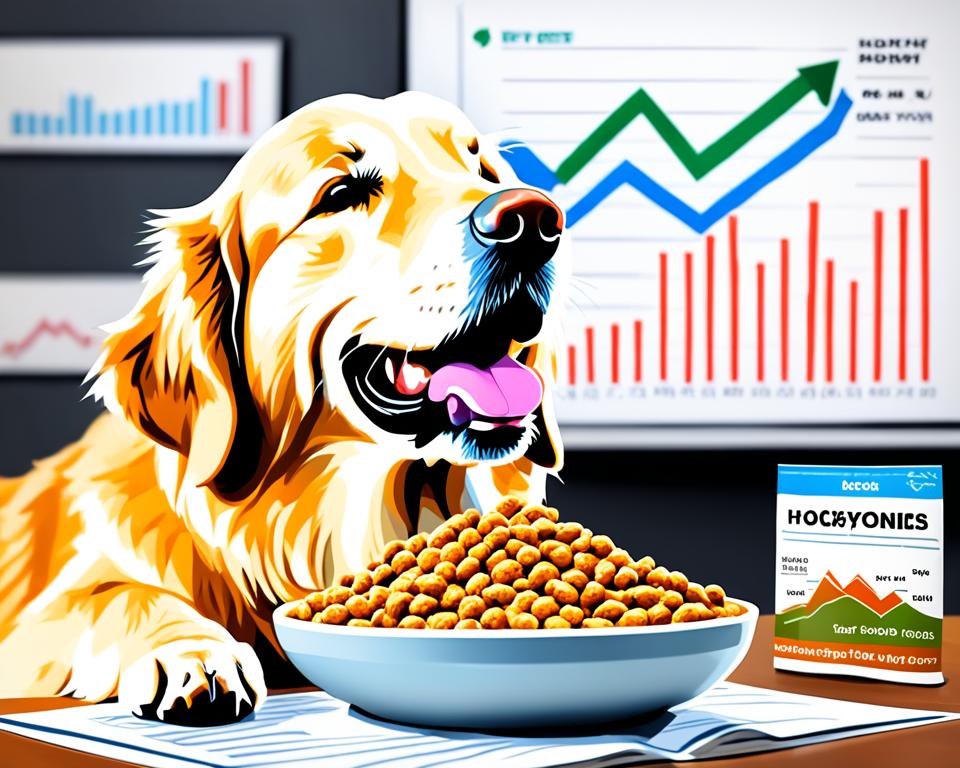Interest in the pet industry has surged during the COVID-19 pandemic, making pet food stocks an attractive investment option. Pet products, including pet food, are considered consumer staples and have proven to be recession-proof. The humanization of pets, increased spending on pet products, and pet adoption trends contribute to the growth of the pet food industry. In this article, we will explore the top pet food stocks to invest in, providing opportunities to tap into the thriving pet food market.
Key Takeaways
- Investing in pet food stocks offers several advantages, including a reliable revenue stream and the recession-proof nature of the pet industry.
- The humanization of pets and increased spending on pet products contribute to the growth of the pet food industry.
- Top pet food stocks to consider investing in include Chewy, Freshpet, Petco Health and Wellness, BARK, Inc., and Central Garden & Pet Company.
- Before investing in pet food stocks, it’s important to consider factors like industry trends, financial health of the company, competitive landscape, valuation, and long-term growth prospects.
- While investing in pet food stocks can be lucrative, it’s important to be aware of potential risks such as market volatility, competition, regulatory changes, economic conditions, and supply chain disruptions.
Table of Contents
Why Invest in Pet Food Stocks?
Investing in pet food stocks offers several advantages. Pet products, including pet food, are repeat purchases, providing a reliable revenue stream for pet food companies. It is a recession-proof sector, as pet owners are willing to spend on their pets regardless of economic conditions. The humanization of pets has also led to increased spending on pet products, including high-quality pet food. Additionally, the surge in pet adoptions during the pandemic has further boosted the demand for pet food. These factors make pet food stocks an attractive investment option with long-term growth potential.
The Benefits of Investing in Pet Food Stocks
- Reliable Revenue Stream: Pet products, including pet food, are repeat purchases, ensuring a consistent revenue stream for pet food companies.
- Recession-Proof Sector: Regardless of economic conditions, pet owners prioritize spending on their pets, making pet food stocks resilient during economic downturns.
- Humanization of Pets: With pets increasingly considered as members of the family, pet owners are willing to invest in high-quality pet food, driving demand for pet food companies.
- Surge in Pet Adoptions: The pandemic has witnessed a surge in pet adoptions, which has significantly increased the demand for pet food. This trend is expected to continue, benefiting pet food stocks.
Investing in pet food stocks not only offers the potential for capital appreciation but also allows investors to support a thriving industry driven by the love and care for our furry friends.
Top Pet Food Stocks to Consider
When it comes to investing in the pet food industry, there are several top pet food stocks that should be on your radar. These companies have established a strong presence in the market and offer promising opportunities for investors. Whether you’re looking for pet food company stocks or simply the best pet food stocks to invest in, these options are worth considering.
| Company | Ticker Symbol | Description |
|---|---|---|
| Chewy | NYSE: CHWY | Online retailer of pet food and other pet products, with a large customer base and a subscription-based model. |
| Freshpet | NASDAQ: FRPT | Maker of fresh and natural pet foods, with a focus on providing high-quality, refrigerated pet meals. |
| Petco Health and Wellness | NASDAQ: WOOF | Brick-and-mortar retailer of pet products, including pet food, with a wide range of services offered. |
| BARK, Inc. | NYSE: BARK | Online subscription seller of dog-themed products, including treats and toys. |
| Central Garden & Pet Company | NASDAQ: CENT | Distributor and wholesaler of a wide range of garden and pet products. |
With these top pet food stocks, investors have the opportunity to tap into the growing pet food industry. Whether you’re interested in online retailers, makers of fresh pet foods, or brick-and-mortar retailers, there is a variety of options to suit your investment preferences. However, as with any investment, it’s essential to conduct thorough research, analyze the financial health of the companies, and consider the competitive landscape before making investment decisions.
Key Considerations for Investing in Pet Food Stocks
Before investing in pet food stocks, it’s important to consider the following factors:
- Industry trends: Stay updated on the latest trends in the pet food industry, such as the shift towards natural and organic pet food, and the growing demand for premium pet products.
- Financial health of the company: Analyze the financial performance of the pet food company, including revenue growth, profitability, and debt levels.
- Competitive landscape: Assess the competitive position of the company within the pet food market. Look for companies with a strong brand presence and a competitive advantage.
- Valuation: Evaluate the valuation of the pet food stock, considering factors such as price-to-earnings ratio and price-to-sales ratio.
- Long-term growth prospects: Consider the long-term growth potential of the pet food company, including expansion plans, new product launches, and market opportunities.
Considering these key factors will help you make more informed decisions when investing in pet food stocks, increasing your chances of success in this thriving industry.
Financial Health and Valuation Comparison
Here is a comparison of the financial health and valuation of selected pet food stocks:
| Company | Revenue Growth | Profitability | Debt Level | Valuation |
|---|---|---|---|---|
| Chewy | 10% | Positive | Moderate | P/E: 60, P/S: 4.5 |
| Freshpet | 20% | Positive | Low | P/E: 80, P/S: 6.2 |
| Petco Health and Wellness | 5% | Positive | Moderate | P/E: 40, P/S: 3.8 |
| BARK, Inc. | 15% | Negative | Low | P/E: 75, P/S: 5.9 |
| Central Garden & Pet Company | 8% | Positive | Low | P/E: 50, P/S: 4.2 |
It’s essential to evaluate both the financial health and valuation of pet food stocks before making investment decisions. This comparison table provides a quick overview of selected companies in the industry, but it’s recommended to conduct further research and analysis to make well-informed investment choices.
Risks of Investing in Pet Food Stocks
While investing in pet food stocks can be a lucrative opportunity, it’s important to be aware of the potential risks that come with it. Understanding these risks will help investors make informed decisions and manage their investment portfolio effectively. Let’s take a closer look at some of the potential risks of investing in pet food stocks:
- Market volatility: Like any investment, pet food stocks are subject to market volatility. Fluctuations in the stock market can impact the prices of pet food stocks, leading to potential losses. It is crucial to carefully analyze market trends and make informed investment decisions.
- Competition: The pet food industry is highly competitive, with new entrants and changing consumer preferences. Companies need to constantly innovate and stay ahead of the competition to maintain market share and drive stock performance. Investors should closely monitor a company’s competitive position and its ability to adapt to market changes.
- Regulatory changes: Changes in regulations related to pet food manufacturing and distribution can have a significant impact on pet food companies’ operations and profitability. New regulations or stricter compliance requirements can increase costs, affect product formulations, and potentially disrupt supply chains. Investors should follow regulatory developments closely.
- Economic conditions: Economic downturns and recessions can influence consumer spending patterns, including their expenditure on pet products such as pet food. During challenging economic times, consumers may prioritize essential needs over pet-related expenses. As a result, pet food companies may experience a decline in demand, which can negatively affect their stock prices.
- Supply chain disruptions: Disruptions in the pet food supply chain, such as natural disasters or pandemics, can impact the availability and cost of pet food ingredients. These disruptions can result in production delays, increased costs, and potential inventory shortages. Investors should consider a company’s supply chain resilience and its ability to navigate such disruptions.
| Risks of Investing in Pet Food Stocks | Description |
|---|---|
| Market volatility | Fluctuations in stock prices due to market conditions and investor sentiment. |
| Competition | Intense competition in the pet food industry that can impact a company’s market position and stock performance. |
| Regulatory changes | Changes in regulations that govern pet food manufacturing and distribution, affecting companies’ operations and profitability. |
| Economic conditions | Impact of economic downturns and recessions on consumer spending on pet products, potentially leading to reduced demand for pet food. |
| Supply chain disruptions | Disruptions in the pet food supply chain, such as natural disasters or pandemics, impacting ingredient availability and costs. |
It’s important for investors to carefully assess these risks and conduct thorough research before making investment decisions in the pet food sector. By understanding the risks and potential challenges, investors can make informed choices to navigate the dynamic nature of the pet food market.
How to Invest in Pet Food Stocks
To invest in pet food stocks, follow these steps:
- Research: Conduct thorough research on the pet food industry, individual companies, and specific stocks of interest.
- Choose a brokerage: Open a brokerage account that allows you to trade stocks.
- Determine investment goals: Define your investment goals, whether it’s long-term growth or short-term gains.
- Develop a portfolio strategy: Allocate a portion of your investment portfolio to pet food stocks based on your risk tolerance and investment objectives.
- Monitor and adjust: Regularly monitor the performance of your pet food stocks and make adjustments as needed based on market trends and individual company performance.
| Steps to Invest in Pet Food Stocks |
|---|
| Research |
| Conduct thorough research on the pet food industry, individual companies, and specific stocks of interest. |
| Choose a brokerage |
| Open a brokerage account that allows you to trade stocks. |
| Determine investment goals |
| Define your investment goals, whether it’s long-term growth or short-term gains. |
| Develop a portfolio strategy |
| Allocate a portion of your investment portfolio to pet food stocks based on your risk tolerance and investment objectives. |
| Monitor and adjust |
| Regularly monitor the performance of your pet food stocks and make adjustments as needed based on market trends and individual company performance. |
Conclusion
Investing in pet food stocks presents a compelling opportunity to capitalize on the thriving pet food market and the growing demand for pet products. With a reliable revenue stream, recession-proof nature, and the increasing trend of pet humanization, pet food stocks have the potential for long-term growth and profitability.
However, it is crucial to assess the risks and conduct thorough research before making investment decisions. Factors such as market volatility, competition, regulatory changes, economic conditions, and supply chain disruptions can impact the performance of pet food stocks. By staying informed and considering these factors, investors can make informed choices and minimize potential risks.
To get started with investing in pet food stocks, follow the steps outlined in this article. Conduct comprehensive research on the pet food industry, select a reputable brokerage, define your investment goals, develop a portfolio strategy, and actively monitor and adjust your investments as needed. Through careful evaluation and proactive management, investors can position themselves to potentially benefit from the long-term growth prospects of pet food stocks.


